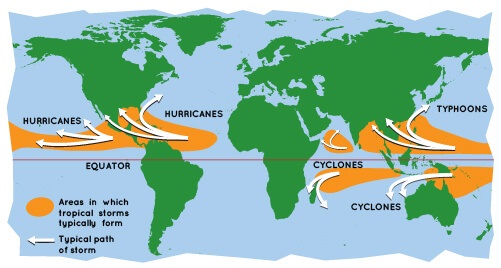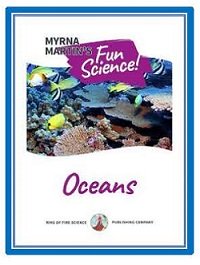change in the weather is predicted
What causes Changes in the weather
The rotation of the Earth each day and Earth’s orbit around the Sun causes uneven heating of the Earth’s surface. The uneven heating of the Earth is what causes weather to be sunny and hot in one place and a blizzard with freezing conditions somewhere else.

Hurricanes, Cyclones and Typhoons NOAA
How tropical cyclones form
Tropical cyclones form in tropical or subtropical regions over the oceans. The water in these regions is warmer than other parts of the Earth. The warmth of the oceans causes the air above the water to warm and become less dense.
The warm air rises creating a low-pressure area near the surface of the ocean and clouds in the atmosphere. Air blowing into the area is heated by the warm ocean water and it flows upward where it cools and condenses into rain clouds. This movement of the air creates a rotating system of clouds and thunderstorms. The rotating air is what causes the weather to form tropical cyclones.

The Oceans book contains chapters on the seafloors, tide pools, estuaries and fantastic fish in this fun book to read and the activities included in the book. Myrna

Click for More Information and to Order
Tropical depressions become tropical cyclones
Tropical depressions are storms with a maximum sustained windspeed of 39 mph (63 k/h). As the speed of the winds increases the tropical depression becomes a tropical storm. Sustained winds of tropical storms are between 39 - 72 mph (63 - 87 km/h)
Hurricanes, typhoons and cyclones
Tropical cyclones form hurricanes, typhoons and cyclones when wind speeds increase to 72 mph (87 km/h). Major hurricanes, tropical cyclones and typhoons have different categories depending on the sustained speed of the winds in the system. There are several scales used in different parts of the Earth that determine the severity of these storms. Use a search engine to find the different categories that are used where you live.
Hurricanes, typhoons and cyclones are all tropical storms. The name given to tropical storms as the wind speeds increase depends on where the storm develops. Hurricanes form over the North Atlantic Ocean and the Northeast Pacific Ocean. Typhoons are tropical storms in the Northwest Pacific Ocean. Cyclones is the name given for these storms in the South Pacific Ocean and Indian Ocean.
What causes tornadoes
Tornadoes are the hardest weather events for meteorologist to predict. The reason they are so hard to predict is that they form spontaneously, they are short lived, and they only travel on the ground for a short period of time.
What causes weather conditions in an area to form tornadoes? The air near the ground must be hot and humid. A cool air mass must be in the atmosphere as the hot and humid air rises. Strong winds must be blowing in the atmosphere causing wind shear and the air to spin.
Links to What Causes Weather
Thunderstorm clouds form when warm air currents rise above the Earth’s surface creating cumulonimbus clouds. These clouds produce rain, lightning, hail and occasionally tornadoes.
Weather Facts: The weather affects our everyday lives throughout the year. Use the links on this page to learn about hurricanes, the Earths atmosphere layers, air pressure, lightning and thunderstorms.
Formation of hurricanes in North Pacific Ocean occurs in two basins. They are the two most active basins for cyclones to form on our planet. Meteorologist recognized the north eastern Pacific Ocean basin 1920s.
The Earths atmosphere layers are similar to the interior of the Earth. Find out about the four major layers of atmosphere that are separated by temperature.
What is air pressure? It is the weight of air molecules pressing down on the Earth. The pressure changes as you move upward into the atmosphere.
What causes lightning and what are the warning signs before lightning strikes? Find out on this fascinating page about lightning.
What are thunderstorm clouds and how do they form? Find out how severe thunderstorms produce rain, lightning, hail and occasionally tornadoes.
KIDS FUN Science Bookstore
Check out Myrna Martin's award winning textbooks, e-books, videos and rock sets. The Kids Fun Science Bookstore covers a wide range of earth science topics. Click here to browse.










